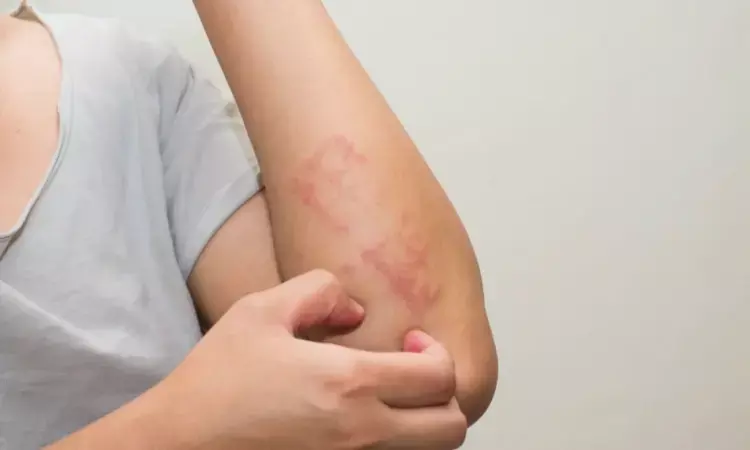- Home
- Medical news & Guidelines
- Anesthesiology
- Cardiology and CTVS
- Critical Care
- Dentistry
- Dermatology
- Diabetes and Endocrinology
- ENT
- Gastroenterology
- Medicine
- Nephrology
- Neurology
- Obstretics-Gynaecology
- Oncology
- Ophthalmology
- Orthopaedics
- Pediatrics-Neonatology
- Psychiatry
- Pulmonology
- Radiology
- Surgery
- Urology
- Laboratory Medicine
- Diet
- Nursing
- Paramedical
- Physiotherapy
- Health news
- Fact Check
- Bone Health Fact Check
- Brain Health Fact Check
- Cancer Related Fact Check
- Child Care Fact Check
- Dental and oral health fact check
- Diabetes and metabolic health fact check
- Diet and Nutrition Fact Check
- Eye and ENT Care Fact Check
- Fitness fact check
- Gut health fact check
- Heart health fact check
- Kidney health fact check
- Medical education fact check
- Men's health fact check
- Respiratory fact check
- Skin and hair care fact check
- Vaccine and Immunization fact check
- Women's health fact check
- AYUSH
- State News
- Andaman and Nicobar Islands
- Andhra Pradesh
- Arunachal Pradesh
- Assam
- Bihar
- Chandigarh
- Chattisgarh
- Dadra and Nagar Haveli
- Daman and Diu
- Delhi
- Goa
- Gujarat
- Haryana
- Himachal Pradesh
- Jammu & Kashmir
- Jharkhand
- Karnataka
- Kerala
- Ladakh
- Lakshadweep
- Madhya Pradesh
- Maharashtra
- Manipur
- Meghalaya
- Mizoram
- Nagaland
- Odisha
- Puducherry
- Punjab
- Rajasthan
- Sikkim
- Tamil Nadu
- Telangana
- Tripura
- Uttar Pradesh
- Uttrakhand
- West Bengal
- Medical Education
- Industry
Isothiazolinone allergy in Europe on decline but rising in USA due to differences in regulation: JAMA

USA: A recent study published in JAMA Dermatology suggests that isothiazolinone allergy is decreasing in Europe, whereas allergy continues to increase in North America. This trend may be due to more stringent and earlier government regulation of methylisothiazolinone (MI) in Europe.
Personal care products are the most frequent source of MI contact allergy; other novel exposures include household products, paint, slime, industrial chemicals, adhesive agents, and slime. Methylisothiazolinone is a commonly used preservative for water-based personal care products. Other isothiazolinones, such as octylisothiazolinone and benzisothiazoline, are uncommon in personal care products but have been found in glue, leather products, paints, industrial chemicals, and cleaning products. Increases in MI's allowable concentrations in these products have led to an epidemic of allergic contact dermatitis.
The everyday use of isothiazolinones as preservatives is a worldwide cause of allergic contact dermatitis. Differences in allowable concentrations of methylisothiazolinone exist in Europe, the US, and Canada. Margo J. Reeder from the University of Wisconsin, School of Medicine and Public Health, Madison, and colleagues aimed to compare the prevalence of positive patch test reactions to the methylisothiazolinone/methylchloroisothiazolinone (MI/MCI) combination and MI alone in North America and Europe from 2009 to 2018. They addressed the question, "how does the prevalence of methylchloroisothiazolinone/methylisothiazolinone allergy compare between Europe and North America?"
For this purpose, the researchers conducted a retrospective analysis of the ESSCA (European Surveillance System on Contact Allergies), the North American Contact Dermatitis Group, and the IVDK (Information Network of Departments of Dermatology) databases, including data from patients presenting for patch testing at clinics in Europe and North America.
Exposures included patch tests for MCI/MI and MI. The team determined the prevalence of allergic contact dermatitis to MI and MCI/MI (main outcome measures).
The study led to the following findings:
- Participating sites in North America and Europe patch-tested 226 161 people to MCI/MI and 118 779 to MI from 2009 to 2018.
- In Europe, positivity to methylchloroisothiazolinone/methylisothiazolinone peaked during 2013 and 2014 at 5.4% (IVDK) and 7.6% (ESSCA) before decreasing to 3.2% (IVDK) and 4.4% (ESSCA) in 2017 and 2018.
- During 2017 and 2018, positive reactions to methylisothiazolinone were 3.4% (IVDK) and 5.5% (ESSCA).
- In North America, through the study period, the positivity to MCI/MI frequency rose steadily, reaching 10.8% for MCI/MI during 2017 and 2018.
- During 2017 and 2018, positive reactions to methylisothiazolinone were 15.0%.
"Our study's findings indicate that in contrast to the continued increase of isothiazolinone allergy in North America, there is a decline in Europe," the researchers wrote. "This trend corresponds with earlier and more stringent government regulation of methylisothiazolinone in Europe."
Reference:
Reeder MJ, Warshaw E, Aravamuthan S, et al. Trends in the Prevalence of Methylchloroisothiazolinone/Methylisothiazolinone Contact Allergy in North America and Europe. JAMA Dermatol. Published online January 18, 2023. doi:10.1001/jamadermatol.2022.5991
Dr Kamal Kant Kohli-MBBS, DTCD- a chest specialist with more than 30 years of practice and a flair for writing clinical articles, Dr Kamal Kant Kohli joined Medical Dialogues as a Chief Editor of Medical News. Besides writing articles, as an editor, he proofreads and verifies all the medical content published on Medical Dialogues including those coming from journals, studies,medical conferences,guidelines etc. Email: drkohli@medicaldialogues.in. Contact no. 011-43720751


